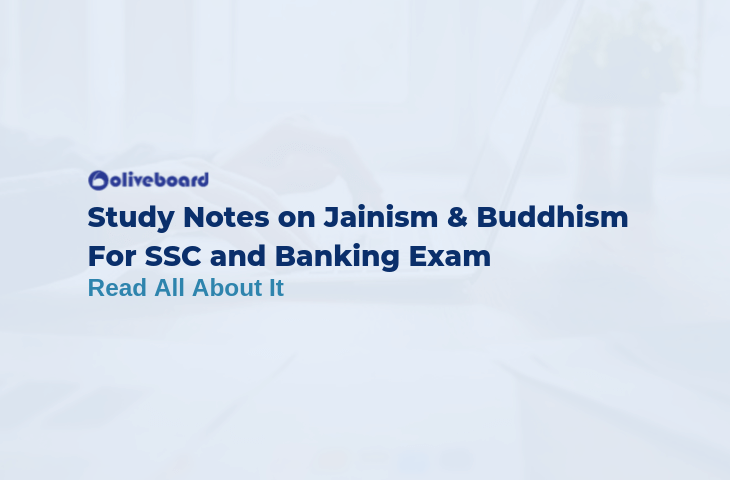General Awareness is one of the most prominent section in any of the government exam like- SSC, Banking, etc. For every banking and government job aspirant, staying up to date with static as well as current affairs is a must. If you too are preparing for an SSC, Banking or any government job, Study Notes on Buddhism and Jainism is a very important topic and questions asked from Buddhism and Jainism are very common. So, if you want to score well in these exams do go through the following blog. To help you with the topic we are here with this blog on Study Notes on Buddhism and Jainism.
Attempt free general awareness mock test on Oliveboard
Study Notes on Buddhism and Jainism
Buddhism and Jainism – Their Emergence
By 6th Century BC, the caste system became highly complicated and the lower caste people faced all socio-economic problems while high caste people led a safe and dignified life. These lower caste people were ready to move to some other religion where there were no such discriminations. An it was during this time new religions like Jainism, Buddhism and many other religions emerged. They acted as an alternative to the present caste system and many other people started following these new religions where they could live a life with dignity.
Attempt free general awareness mock test on Oliveboard
Buddhism
- Founder: Siddhartha( also known as Buddha) (563 BC- 483 BC) was born at Lumbini garden near Kapilavastu. Left palace at the age of 29 and started traveling in the search of truth.
- At the age of 35, he was sitting under a Banayan tree modern Bodh Gaya, after taking a bath in the stream of a river Niranjana, modern Lilajan, and obtained enlightenment and became known as Buddha.
- Delivered the first sermon at Sarnath, and this is called “Dharmachakrapracartan” or “Tuning of the weel of law”.
- Taught his followers Four Noble Truths:
- The world is full of sorrows.
- Desire is the root cause of sorrow.
- The desire if conquered, all sorrows can be removed.
- Desire can be removed by following the Eight Fold Path.
- Eight-Fold Path is right understanding, right speech, right livelihood, right mindfulness, right thought, right action, right effort, right concentration.
- Buddhism was totally against Varna System.
- Buddha died in Kushinagara capital of Mahajanapada in 483 BC.
- After his death four Buddha Councils were held
| Council | Year | Place | King | President of Council | Important Features |
| 1 | 483 BC | Rajgir | Ajatasatru | Mahakassapa | Two important literary works were published 1. Sutta Pitaka: Deals with the life history of Buddha. 2. Vinay Pitaka: Deals with monastic discipline. |
| 2 | 383 BC | Vaishali | Kalashoka | Sabakami | |
| 3 | 250 BC | Patliputra | Ashoka | Moggliputta Tissa | One of the important literary work was published: Abhidhamma Pitaka: Deals with mystic concept beyond the knowledge. |
| 4 | First Century AD | Kundalawana (Kashmir) | Kanishka | Vasumitra | Buddhist split into two: Hinayana: No ideal worship. Mahayana: Started Idol worship. |
Attempt free general awareness mock test on Oliveboard
Sects:
Hinayana: They believed in the real teachings of Gautam Buddha acquiring Nirvana and they do not believe in ideal worship. Pali language was used in Hinayana text.
Mahayana: Started Idol worship and Sanskrit was used in Mahanaya text.
Vajrayana: They believe that the real teachings of Gautam Buddha is attained by the help of black magic.
Attempt free general awareness mock test on Oliveboard
Jainism
- According to Jain tradition, there were 24 Tirthankaras. Rishabha was the first Tirthankara and Vardhaman Mahavira was the 24th Tirthankara.
- Mahavira was born in 540 BC Kundagrama near Vaishali, and left his home at the age of 30.
- At the age of 42, he attained the highest spiritual knowledge called Kevala-Jnana.
- As per Jainism way to Nirvana is also known as Three Ratnatraya involves Right faith, Right knowledge and Right conduct.
- Five carinal principles of Jainism are Ahimsa, Non-Lying, Non-Stealing, Non-Possession, and Brahmacharya.
- Later divided into two sects: Swethembaras and Digambaras.
- Jain Councils
1. First Council: held at Patliputra by Sthulabahu at the beginning of the third century BC and resulted in the compilation of 12 Angas.
2. Second Council: Held at Valabhi in the 5th century AD, under the leadership of Devaradhi Kshamasramana. Attempt free general awareness mock test on Oliveboard
Five types of knowledge:
- Mati Janana.
- Shruta Janana.
- Avadhi Janana.
- Manahparayaya Jnana.
- Keval Jnana.
Attempt free general awareness mock test on Oliveboard
This was all in this Blog for Study Notes on Buddhism and Jainism. We hope you liked reading the information about the Buddhism and Jainism provided above. For more fresh updates and Exam related contents keep following this space.
Start preparing for Bank, SSC and Government exams with Oliveboard. For the best Live courses and Mock Tests series Subscribe to Oliveboard Edge today and give an extra edge to your preparation.
Also Check:
